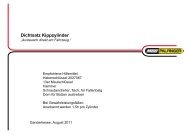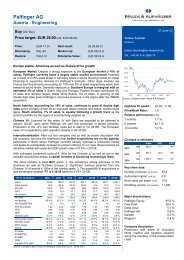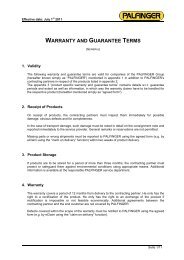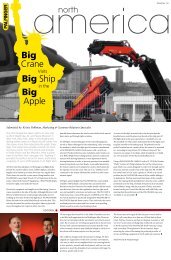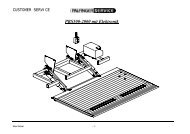palfinger at a glance
palfinger at a glance
palfinger at a glance
Create successful ePaper yourself
Turn your PDF publications into a flip-book with our unique Google optimized e-Paper software.
search Print<br />
noteS TO THE CONSolid<strong>at</strong>ed FINANCIAL St<strong>at</strong>ementS<br />
conSolid<strong>at</strong>ed FINANCIAL St<strong>at</strong>ementS FOR THE Year ENDED 31 DECEMBER 2011<br />
(8) LONG-term EMPLOYment BENEFITS<br />
Defined benefit plans<br />
Defined benefit plans apply to pension commitments in Austria and Germany as well as severance pay oblig<strong>at</strong>ions<br />
in Austria, Slovenia and Bulgaria.<br />
Employees whose employment contract is governed by Austrian law and whose employment st<strong>at</strong>us started<br />
before 1 January 2003 are entitled to a severance payment if their contract is termin<strong>at</strong>ed by the employer or<br />
if they leave the company early for good cause, provided th<strong>at</strong> their employment lasted for three years without<br />
interruptions. In addition, if their employment lasted for <strong>at</strong> least ten years, they are entitled to a severance payment<br />
upon any kind of termin<strong>at</strong>ion of employment when they have reached the st<strong>at</strong>utory pensionable age. The<br />
amount of the severance payment depends on the amount of the remuner<strong>at</strong>ion paid <strong>at</strong> the time of termin<strong>at</strong>ion<br />
and the length of service.<br />
Provisions for pensions and other post-retirement benefits as well as for severance payments and anniversary bonuses<br />
are valued using the projected unit credit method. Under this method, anticip<strong>at</strong>ed benefits are distributed<br />
over the working lifespan of the employees until retirement. Anticip<strong>at</strong>ed future salary increases are taken into account.<br />
The amounts of the provisions are determined on the basis of an actuarial opinion prepared by an actuary<br />
as <strong>at</strong> the balance sheet d<strong>at</strong>e.<br />
According to IAS 19, actuarial gains and losses are recognized in the balance sheet if they rel<strong>at</strong>e to provisions for<br />
pensions and other post-retirement benefits or for severance payments.<br />
Defined contribution plans<br />
Defined contribution plans have been introduced <strong>at</strong> various Group companies on the basis of st<strong>at</strong>utory oblig<strong>at</strong>ions.<br />
In addition, individual pension agreements have been entered into. Contributions to such defined contribution plans<br />
are recognized as expenses in the period for which they are paid.<br />
Other long-term employment benefits<br />
Other long-term employment benefits refer primarily to collective bargaining commitments for payment of<br />
anniversary bonuses depending on years of service for the employees of Austrian and Slovenian companies. In<br />
accordance with IAS 19, actuarial gains and losses are recognized as employee benefits expenses in the income<br />
st<strong>at</strong>ement if they rel<strong>at</strong>e to provisions for anniversary bonuses.<br />
(9) OTHER PROVISionS<br />
Other provisions were formed to reflect the level of uncertain liabilities, recognizing the amount associ<strong>at</strong>ed with<br />
the highest level of probability of occurrence of individual oblig<strong>at</strong>ions as the best estim<strong>at</strong>e. Where the provision<br />
being measured involved a large popul<strong>at</strong>ion of items, the expected-value method of estim<strong>at</strong>ion was applied.<br />
Non-current provisions are reported <strong>at</strong> their present value.<br />
(10) LIABILITIES FROM PUTTABLE NON-controlling INTERESTS<br />
Puttable or fixed-term interests held by non-controlling shareholders of subsidiaries constitute financial liabilities<br />
and are reported under “liabilities from puttable non-controlling interests”. At first, the liabilities are recognized<br />
<strong>at</strong> the fair value of the interest held by the non-controlling shareholder in the subsidiary <strong>at</strong> the time the oblig<strong>at</strong>ion<br />
was entered into. Provided th<strong>at</strong> the other shareholders are the beneficial owners of the interests, the results<br />
and payments are still <strong>at</strong>tributed to the non-controlling interests. At the balance sheet d<strong>at</strong>e, they are reclassified<br />
to liabilities, and differences, if any, between the non-controlling interest and the oblig<strong>at</strong>ion are presented under<br />
retained earnings. If, however, the other shareholders are not the beneficial owners, they are presented as an<br />
acceler<strong>at</strong>ed acquisition.<br />
<strong>palfinger</strong> Annual Report 2011<br />
129






